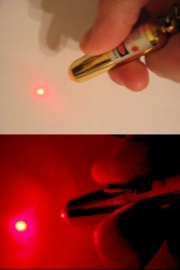Laser pointer
Jump to navigation
Jump to search
Description
A small, handheld diode Laser that emits an intense beam of light. Laser pointers were originally sold as tools for lectures in classrooms, conventions, and meetings. Low energy red light lasers (class 2) are generally acceptable for use in gallery talks as the UV-free, low energy wavelengths are not permanently fixed to a single position.
Laser pointers fall into the following classes:
- Class 2: power output of less than 1 milliwatt (mW). These red (630-680 nm) light lasers are generally considered safe. They should have an FDA label of CAUTION: Laser Radiation. Most laser pointers made before 1993 are class 2.
- Class 3a: maximum power output between 1 and 5 mW. These are also red (630-680 nm) lasers but increased power increases potential hazards to the eye. They should have an FDA label of DANGER: Laser Radiation.
- Class 3b: emit green light (532 nm) with a maximum power up to 15 mW. These laser pointers, usually imported from China or Russia, exceed permissible exposure levels and are hazardous. They are unlabeled.
Synonyms and Related Terms
Laserpointer (Deut.)
Risks
Direct laser light in the eye for an extended period of time may cause damage. Short exposures should not cause permanent damage, but may cause temporary flash blindness, headaches, afterimages, or glare.
Resources and Citations
- Laser Institute of America: Laser Pointer Safety
- Encyclopedia Britannica, http://www.britannica.com Comment: laser." (Accessed 10 Mar. 2005).
- Wikipedia: http://en.wikipedia.org/wiki/Laser_pointer (Accessed Feb. 2, 2006)
- The American Heritage Dictionary or Encarta, via Microsoft Bookshelf 98, Microsoft Corp., 1998
